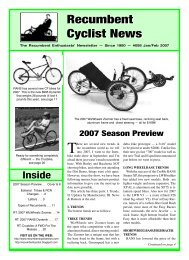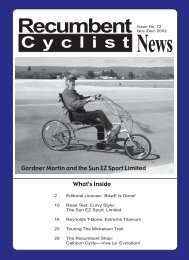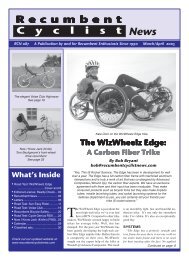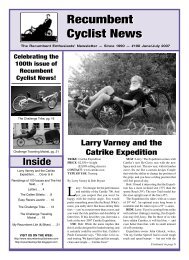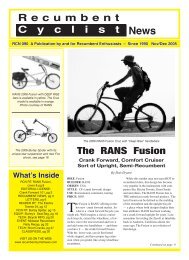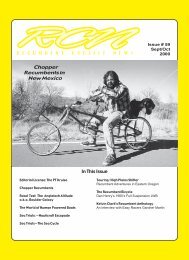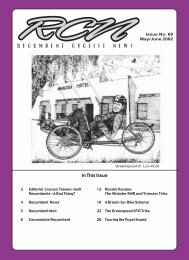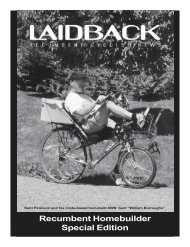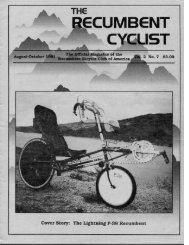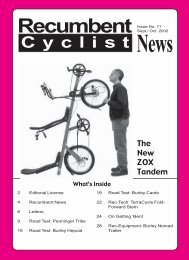What's Inside
What's Inside
What's Inside
Create successful ePaper yourself
Turn your PDF publications into a flip-book with our unique Google optimized e-Paper software.
fast bike to hang in on a fast road bike club<br />
ride. Recumbents have different power curves.<br />
They tend to be faster on the flats and descents<br />
and slower on any kind of hills. This makes for<br />
sort of a rubber-band effect. Many roadies don't<br />
appreciate this.<br />
While there are more performance-oriented<br />
recumbents these days, some are more extreme<br />
(laid back seat + high BB) than you might be<br />
willing to put up with.<br />
In contast, upright road bikes are lighter and<br />
faster than they have ever been and recumbents<br />
have a difficult time competing against the<br />
state-of-the-art road technologies and affordable<br />
sub-20 pound road bikes.<br />
A fully-faired recumbent is the fastest (like a<br />
Lightning F-40). Lowracers (like a Velokraft)<br />
and highracers are next (Volae, RANS & Bacchetta),<br />
followed closely by a partially faired<br />
LWB OSS with a body sock (Easy Racers).<br />
Expect just average performance from most<br />
entry level recumbents, SWB, LWB and trikes.<br />
CLWB is probably being the slowest type of<br />
recumbent. Trikes can be very fast, but usually<br />
can't match the speeds of a highracer, lowracer<br />
or LWB OSS with a body stocking.<br />
A typical long wheelbase recumbent might<br />
be faster than other (non-faired) recumbents on<br />
the flats and down hills, but it will usually be<br />
slower up hills (heavier bike). Riders on drop<br />
bar road bikes will notice slower recumbent<br />
speeds more than typical recreational riders.<br />
Recumbent performance really shines on the<br />
flats and downhills. Hill climbing is where the<br />
speeds drop significantl for many, but not all,<br />
riders.<br />
Hill Climbing: Recumbents are usually<br />
slower up hills because they are heavier, riders<br />
can’t stand on the pedals and/or rock the<br />
bike back and forth (using upper body). This<br />
point was really made clear to me when I started<br />
experimenting with a single speed rainy day<br />
commuter. With no gears, my only choice was<br />
to stand on the pedals when I came to a hill. In<br />
contrast, most recumbent riders shift into an<br />
easier pedaling gear when they come to a hill.<br />
When I rode the Slumgullion Colorado tour,<br />
I trained myself to stay in the middle chainring<br />
longer because the minute you dump into granny<br />
low gear, you lose all of your momentum<br />
(you need the muscles and wind power to pull<br />
this off).<br />
Riders who train both aerobically, building<br />
their leg strength and doing interval training<br />
(or add a steep hill to your daily ride) will see<br />
immediate improvements in their recumbent<br />
climbing ability. The faster recumbents are<br />
faster up hills, but there are other hill climbing<br />
secrets:<br />
• Install a lower low gear<br />
• Install a lower mid-range gear<br />
• Consider shorter crank arms which help<br />
promote spin<br />
Here are some other climbing tips:<br />
• Spin in a low gear<br />
• If you are a strong rider, stay in your middle<br />
chainring as long as you can<br />
• Push your back into the seat back<br />
• Sway the bars back and forth in rhythm with<br />
your climb (try not to weave)<br />
Not every tip will work for every rider on<br />
every style of bike. See what works best for you,<br />
and make sure your bike is properly geared for<br />
your home terrain.<br />
FIRST RIDE/LEARNING CURVE<br />
Some recumbent types are easier to ride than<br />
others. I suggest that you test ride recumbents<br />
in this order:<br />
1. LWB low pedal, over-seat steering<br />
2. Delta trike<br />
3. Tadpole trike<br />
4. Medium wheelbase<br />
5. Short wheelbase<br />
6. Under-seat steering models.<br />
7. Any under-seat steering model<br />
8. Lowracer<br />
You might want to delete the types that you<br />
aren’t interested in, or you might want to try<br />
every type you can.<br />
You should know how to shift the bike you<br />
are test riding. Don't wing it, ask how to shift<br />
and use the controls properly. You shift gears<br />
more frequently when you ride a recumbent.<br />
Remember that you should always be able to<br />
sit flat-footed at a stop to be safe. Taller riders<br />
may not fit some LWB models (I’m 6’ with<br />
a 44.5” x-seam and barely fit on several oneframe<br />
size models). Shorter riders may not be<br />
able to fit on SWB or highracers.<br />
A recumbent may initially feel foreign to you:<br />
too sensitive, overly quick, or it may take you<br />
some time to get accustomed to the closer-tothe-ground<br />
position. This is especially true for<br />
the recumbent newbie. The word to remember<br />
is RELAX! Lean back in the seat and enjoy the<br />
ride. Many problems can be traced directly to<br />
the habit of upper-body stiffness from riding<br />
your upright. Allow your body to relax and stay<br />
loose. Ride several bikes and decide which design<br />
style to choose.<br />
Keep in mind that starts are slower, and don’t<br />
forget to be in a low enough gear. The higher<br />
the pedals, the more difficult it will be for a new<br />
rider to start out. Try to avoid starting out on<br />
hills if you can.<br />
For your first ride, be sure you have proper<br />
safety equipment and find a quiet street or preferably<br />
a parking lot to practice. Be sure that the<br />
bike is set up for you, and is the proper size bike<br />
for you. Here is how you get on a recumbent:<br />
1. Squeeze one brake lever to keep the bike<br />
from rolling and hold.<br />
- 20 -<br />
2. Straddle the boom or frame and lean back<br />
into the seat.<br />
3. Familiarize yourself with the controls: be<br />
sure you understand how to shift and brake<br />
4. Place your power foot (are you righthanded<br />
or left?) on the right or left pedal in<br />
the 1:00 o'clock position.<br />
5. Power to the pedals as you let go of the<br />
brake and achieve balance.<br />
Remember, ask questions if you need to and<br />
have a friend run along side of you until you<br />
achieve balance. I've seen this sequence take<br />
one minute, and I’ve worked with other people<br />
for an hour. Certainly, a three-wheeler will be<br />
the easiest to learn on. The second easiest is a<br />
low-pedal LWB and third a compact LWB.<br />
SAFETY<br />
Most recumbents are lower than their upright<br />
brethren. Recumbent riders often ride one or<br />
more head levels (the height of your head)<br />
below an upright rider. While this isn’t such a<br />
big deal on a country road, or bike trail, it can<br />
be a big deal in busy urban traffic. Visibility<br />
= Safety; higher is better. We recommend the<br />
following safety equipment: rearview mirror,<br />
safety flag, reflective tape and clothing, tail light<br />
(solid & flasher), head light (if you ride at dusk<br />
or dark), bell (other cyclists or pedestrians) or<br />
air horn (for motor vehicles).<br />
We do not advocate the use of low recumbents<br />
(lowracers, trikes etc.) on city streets and<br />
in urban settings. Low recumbents should only<br />
be used on closed courses, bike trails, rail trails<br />
and perhaps quiet country roads where YOU<br />
feel comfortable and safe riding. (See recumbent<br />
safety article in RCN 087.)<br />
DEALERS & MANUFACTURERS<br />
Take responsibility for your own recumbent<br />
education, here is how to learn more about<br />
recumbents:<br />
• Read RCN and other recumbent magazines<br />
• Subscribe to newsgroups<br />
• Find a local rider group<br />
• Visit several dealers<br />
• Take test rides<br />
• Ask questions<br />
It's important to find a good recumbent dealer.<br />
Many advertise in RCN, online and in other<br />
magazines. Ask around in newsgroups and bike<br />
clubs or local rider groups.<br />
Another good way to track down local and<br />
regional recumbent dealers is to visit builder<br />
websites and see if the company has a local<br />
dealer. The following manufacturers have lots<br />
of dealers listed: Bacchetta, Burley, Catrike,<br />
Easy Racers, RANS and Sun (Recumbents)<br />
Remember to call first before you visit<br />
the shop to see what they have in stock. In<br />
some cases dealers listed may not stock any<br />
bikes.◆



